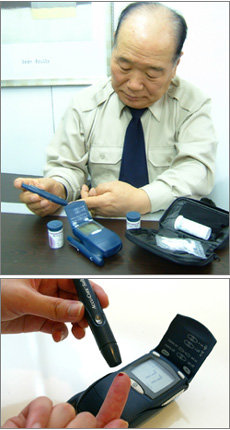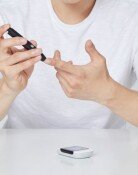Quasi-Diabetes: Stay Away from Relief
Quasi-Diabetes: Stay Away from Relief
Posted February. 13, 2005 22:43,

Quasi-diabetes: a red sign rather than green-
Quasi-diabetes refers to people who have 100-126mg/dL level of blood glucose measured when the stomach is empty, and 140-200mg/dL level measured two hours after a meal. These levels are higher than normal blood glucose levels, but lower than a diagnostic criterion fitting for diabetes.
According to the 2003 resources from the clinical research center at Gangbuk Samsung Hospital, 30 percent and 20 percent of males and females who are over 50 years old were diagnosed as quasi-diabetes patients. It is known that one third of the cases of quasi-diabetes supposedly develop into diabetes within 10 years. Besides the high risk of developing into diabetes, those people also face a high risk of getting heart attacks, strokes and other diseases.
Once a person is diagnosed as having more blood glucose than the standard criterion, he or she has to live the rest of his or her life fighting the disease. Therefore, rather than feeling safe with a quasi-diabetes diagnosis, it is rightful thinking that I am an almost-diabetes patient. Another term referring quasi-diabetes is a pre-stage of diabetes.
Making the effort can put you back to normal-
Meanwhile, the blood glucose level can be reduced to a normal level if quasi-diabetes patients keep exercising and make dietary changes.
The first priority should be weight loss and getting rid of abdominal fat. Those patients should restrict their intake to 1,500 calories per day and have regular exercise. A commonly recommended workout is a 30 minute-long fast walk accompanying perspiration.
The Diabetic Prevention Program (DPP) in the U.S. gave a survey to 3,234 people diagnosed as quasi-diabetes patients for the past three years; the report said that they witnessed a more efficacious result when they corrected their lifestyle through dietary changes and workout, rather when they took diabetes medicines.
Individual blood glucose measurements need to be part of clinical examinations-
Blood sugar levels can increase without giving prior notice. It is safer to become habitual about having a regular blood glucose checkup even though people with quasi-diabetes are not as susceptible to risks from their condition. Nowadays, it is convenient to measure because glucose measuring devices can be had at reasonable prices around 100,000 won.
However, it is dangerous wholly relying on individual blood glucose measurements. At the clinic, blood glucose measuring uses yellow blood plasma. The fresh blood comes from thrusting the tip of a finger with a needle and usually represents 10 to 15 percent lower levels of blood glucose than blood plasma measuring used by clinics.
That can be interpreted when the diagnostic blood glucose level for diabetes - measured when the stomach is empty - drops to 120mg/dL from 140mg/dL when you measure blood glucose using an individual measuring device. Keep in mind that individual measuring is supplementary as a part of the effort to pre-diagnose diabetes. People who have been diagnosed as quasi-diabetics should get examined in a hospital even if they have no abnormal symptoms with their self-measurement of blood glucose.
(References: Professor Lee Mun-gyu of the Endocrinology-Metabolism Department at Samsung Medical Center and Professor Ahn Yoo-heon of the Endocrinology Department at Hanyang University Medical Center.)
TK Sohn sohn@donga.com




![“한동훈, 정치생명 걸고 무소속 출마해 평가받는 것 고려할만”[정치를 부탁해]](https://dimg.donga.com/c/138/175/90/1/wps/NEWS/IMAGE/2026/01/19/133186982.1.jpg)


